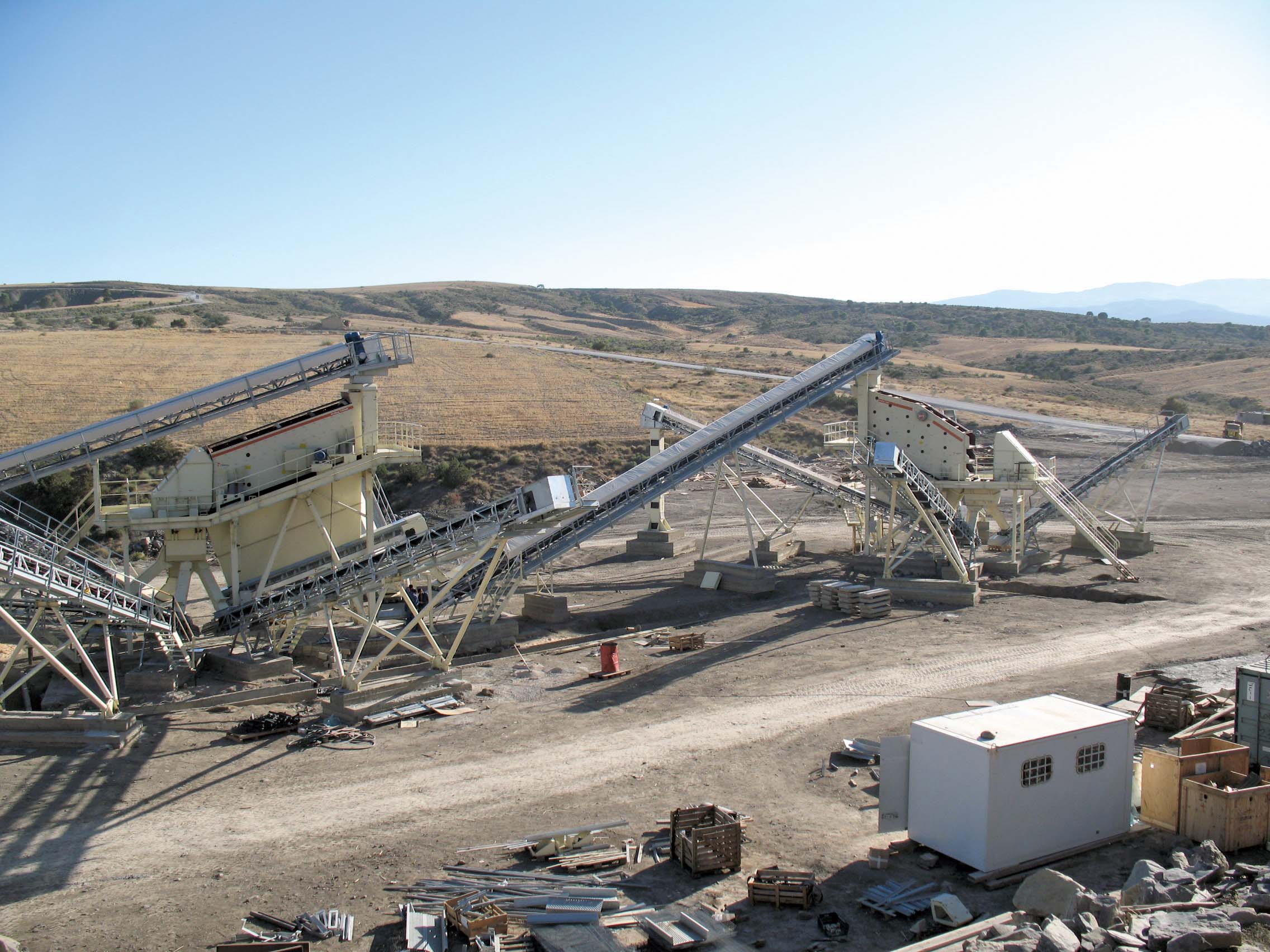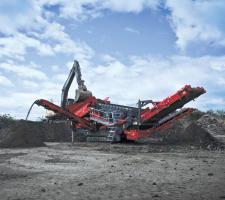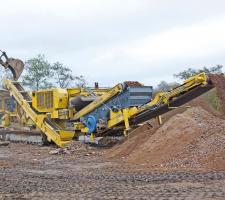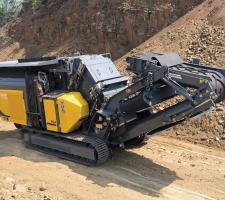
Keestrack’s new Destroyer 1113 crusher has been deployed interchangeably by a Danish company in its recycling processes.
The intermediate version of the track-mounted impact crusher has a secondary screen unit, and is operated by construction and civil engineering company, Kim Vind Maskinstation & Entreprenør, which was founded in 2001, and which has developed into an efficient service provider in the coastal region of Western Denmark, centred around its head office in Årre.
The company offers the recycling of waste building material and excavated soil material from its own construction or demolition projects as well as a sub-contractor at external building sites and materials depots of other building contractors or large agricultural businesses.
According to Kim Vind this work represents at least 20% of today’s business, and the company has been using a track-mounted 30tonne jaw crusher and also a
TNS was shortlisted in 2015 to provide a replacement for the company’s jaw crusher.
“We had an early preference for Keestrack’s impact crusher technology for the operational and material requirements at Kim Vind,” says Thomas Sørensen, TNS managing director.
“Besides a larger Destroyer model we were also able to demonstrate the immediate predecessor of the machine currently deployed to a Danish client. Kim Vind was soon convinced and opted for the first production model of the new Destroyer 1113 machines.”
With the secondary screen unit and recycling conveyor installed the machine weighs 49tonnes (46tonnes without secondary screen unit/recycling conveyor), and with the machine’s compact transport dimensions any relocation can be achieved quickly and easily.
In use, the material first emerges from a 5m³ charge hopper with variable vibrating pan feeder via an active double-deck primary screen to separate the fine particles, which are transported outside the crusher by means of a bypass or are stockpiled laterally.
Keestrack says the heavy build of the 1m-wide rotor with four impact bars (Ø: 1260mm, weighing 5,100kg) and the high crushing area volume guarantee high production rates and a long service life for the equipment.
A vibration chute beneath the crusher transports the crushed material onto the main discharge conveyor where the remote-controlled hydraulically height-adjustable overband magnet separates metallic constituents. The optional single-deck final screen produces two fractions via conventional removable screen media, with the swivel-mounted recycling conveyor returning the oversize grain to the charge hopper or stockpiling it as additional final grain. The optional double-deck module and upgradable mid-grade conveyor for a second value grain size offers higher added value in solo operations.
The machine is controlled and monitored by Keestrack’s SPS-based Relytec controller, which offers many function routines; clear on-screen information and optional wireless remote control; a high level of operating convenience, and smooth operation.
Kim Vind opted for the ECO-FS diesel-hydraulic system with a 298kW
After more than 500 hours of operation, the Destroyer 1113 showed that in the one-man-operation mode with a dedicated machine operator/excavator operator, the machine reliably achieved production rates of between 200tonnes/hour and 260tonnes/hour during typical recycling operations with very diverse building rubble (input: 0/700mm: final grain size: 0/25mm, 0/40mm).
Some 230tonnes/hour has been recorded for gravel production from hardstone (granite/siliceous limestone, final grain size 0/40mm). Average fuel consumption to date of almost 50litres/hour has been calculated.
“The switch to Keestrack’s crusher and secondary screen unit has enabled us to expand our range of services and our customer base. Today we are processing a broader range of raw materials and supplying higher-grade end products, regardless of whether we use demolished concrete, asphalt, natural stone or any other unspecified building material,” says Kim Vind.
When used on construction sites, the Destroyer 1113 comes into its own when equipped with an additional hydraulically driven generator and compressor for small tools.
“The final screen means we can actually often dispense with a machine, making it possible also to process smaller batches in solo operation.”
According to current reports, the Keestrack Destroyer 1113 will have processed more than 100,000tonnes between June and December, 2015.
Account is already being taken of the fact that the company will regularly have to deploy the jaw crusher too, which was actually earmarked as a standby machine.
Meanwhile, by investing in a complete,
Metso and Betonex have signed a contract for the design, delivery and installation of a complete crushing and screening plant to Betonex’s new quarry in El Hamra-Mansourah in the Bordj Bou Arreridj region of Algeria.
Metso says that with the Metso technology, the plant will introduce state-of-the-art equipment never before installed in Algeria.
Betonex aims to change the face of crushing and screening in Algeria with investments in cutting-edge dust suppression equipment to produce the same level of quality seen in Europe, to comply with the new Algerian legislation standard, and to protect the environment and the health of its employees.
The three-stage plant will have a capacity of 500tonnes of 0/15mm/hour.
Metso’s delivery consists of feeders, conveyors, crushers and screens; a dust suppression system; as well as a complete automation system. For the primary stage, Metso will install a Nordberg C120 jaw crusher and a Premier ES horizontal screen.
For Karim Benseba, associate manager of Betonex, Metso is a trusted partner. Benseba had previously invested in Metso technology in 2008 for the company’s other operation, El Mehir Agrégats.
“Aggregates production is the epicentre of our business, and a large part of the aggregates we produce is used by the sister companies of Benseba Group. This is our main reason for investing in a new Metso installation, but we also want to become a major supplier to the construction industry in the region. Housing construction programmes, the Hauts Plateaux highway, and the new expressway between Anhif and Bejaia, reflect the will of the government to make this a priority. We expect the same quality aggregates that are produced in Europe while maintaining affordable prices for the local markets,” says Karim Benseba.
Metso has also received an order for a Metso NW220GPD portable crushing and screening plant to be delivered to Saburkhan Technologies at Aktas, Saran city, Kazakhstan. This order is among the first containerised wheel-mounted crushing plants to be transported overseas.
The combination of the Metso NW106 primary jaw crushing plant and the NW220GPD(TM) secondary cone crushing plant with a large dual-slope screen has been optimised to be relocated regularly.
KwaZulu-Natal aggregate producer Flanders Quarry has expanded its operations and fleet of
The new South African operation, Flanders Canelands, is already underway with the current establishment of a new quarry, and the successful supply of a significant amount of aggregate for use in the construction of the new Cornubia Industrial Development, the Umhlanga Interchange and other local developments.
Central to the growing operation is a new
The RM80 GO! working as the primary crusher on site, and already performing at close to design capacity, is processing decomposed dolerite from a feed size of 500mm at a rate of up to 160tonnes/hour.
Flanders Quarry managing director Karl Stott explains that a second Rubble Master was the logical choice as a mainstay for the new venture.
“It makes sense to stick with tried and tested equipment. We understand the machine, we know how it operates and experience has shown that we can rely on Pilot Crushtec International’s service and technical backup. Our operators are familiar with the machine, like it, and so there is no need to spend valuable time in retraining.”
In Great Britain, the first MOBICAT MC 100 R EVO jaw crusher from
The demolition and recycling company, with its head office in county Durham, north-east England, has already used the crusher on various construction sites and says it is impressed with the technology, the simple handling and the economy of the plant. It is operating the mobile jaw crusher at a low fuel consumption rate.
Managing director Dave Gauja was looking for a mobile jaw crusher for his diverse demolition and recycling work. “A typical job for us involves crushing around 1,000m³ in two to three days. Then it is on to the next construction site. We therefore needed a machine that is easy to transport.”
The MC 100 R EVO optimally satisfies this requirement. “Transportation is made considerably easy with the plant weighing only 30tonnes,” says Gauja, who also sees efficient metal separation as a big plus, because Kleemann installs powerful magnets in the plants.
The Continuous Feed System (CFS) is said to ensure simple handling, with the control adapting the frequencies of the feeder trough and grizzly to the current feed. The material flow is guaranteed, thus resulting in high production capacity.
The crusher jaw allows large parts to be processed in the crusher, preventing blockages of coarse material and protecting the securing elements of the crusher jaw against wear.
“It also facilitates access if a piece of reinforced concrete gets wedged,” says Gauja.
“In this performance class the consumption is typically around 25–30 litres of diesel per hour. The MC 100 R EVO does not guzzle as much fuel. Up to now we operated the plant using only roughly 7.5 litres of diesel per hour. This is fantastic.”
A civil engineering company has ramped up its production process after taking delivery of a new high-tech screener from Finlay Plant Northern, England.
Ashcourt Group, which supplies aggregates and recycling facilities to county Yorkshire and the north-east, brought in the
It features a Spaleck heavy-duty vibrating screen which optimises productivity of moisture-high materials even in damper climates.
“Although we’re using exactly the same process as before, we’ve found that we are producing a far better quality of soil, both for the market and for use on our own projects, since the Terex Finlay 883+ Spaleck arrived on site,” says Paul Dobson, site manager at Ashcourt.
“The plant can still run when it’s wet and even when the material is soggy the machine has never blocked up: that’s quite unusual with a 10mm bottom deck.
“The meshes are really easy to change, it’s just a simple machine to operate.”
At the heart of the plant is the two-deck German designed screen-box, which has processing capabilities for difficult materials such as waste, recycling and slag as well as shredded wood, metal, compost and soil.
The top deck features specially-designed rubber mats, combined with cutting edge Flip-Flow technology on the bottom deck.
At Ashcourt, the plant has been fitted with a 50mm top deck and 10mm bottom deck, processing soil to 10mm down at a production rate of 100tonnes/hour.
The Terex Finlay 883+ Spaleck joins a fleet of machines available for hire at Ashcourt, including wagons, excavators, dumpers, telehandlers and two crushers as well as a Terex Finlay 863 and 883, also supplied by Finlay Plant Northern.
Martin Nairn, of Finlay Plant Northern helped Ashcourt specify the plant.
“The Terex Finlay 883+ Spaleck’s ability to avoid blinding up is incredible,” says Nairn.
“The fact that the machine can process sticky material in wet weather is a major benefit to Ashcourt. It means they can work as normal in wet weather and maintain constant production levels.”


















